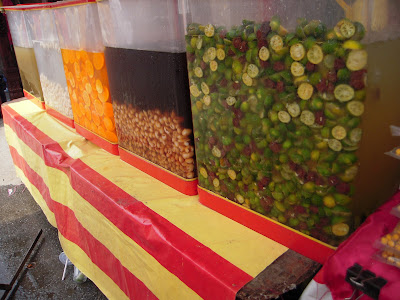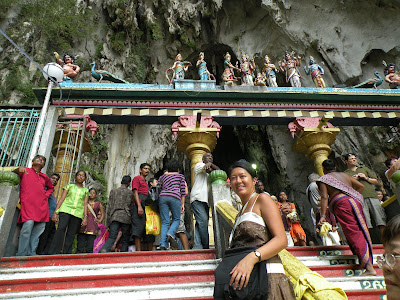
"Devotees prepare for the celebration by cleansing themselves through prayer and fasting. Kavadi-bearing have to perform elaborate ceremonies at the time of assuming the kavadi and at the time of offering it to Murugan. The kavadi-bearer observes celibacy and take only pure Satvik food, once a day, while continuously thinking of God. On the day of the festival, devotees will shave their heads undertake a pilgrimage along a set route while engaging in various acts of devotion notably carrying various types of kavadi (burdens). At its simplest this may entail carrying a pot of milk, but mortification of the flesh by piercing the skin, tongue or cheeks with vel skewers is also common.


 The simplest kavadi is a semi circular decorated canopy supported by a wooden rod that is carried on the shoulders, to the temple. In addition, some have a littlespear through their tongue, or a spear through the cheeks. The spear pierced through his tongue or cheeks reminds him constantly of Lord Murugan. It also prevents him from speaking and gives great power of endurance. Other types of kavadi involve hooks stuck into the back and either pulled by a walking behind or being hung from a decorate bullock cart or more recently a tractor, with the point of incisions of the hooks varying the level of pain. The greater the pain the more god-earned merit."
The simplest kavadi is a semi circular decorated canopy supported by a wooden rod that is carried on the shoulders, to the temple. In addition, some have a littlespear through their tongue, or a spear through the cheeks. The spear pierced through his tongue or cheeks reminds him constantly of Lord Murugan. It also prevents him from speaking and gives great power of endurance. Other types of kavadi involve hooks stuck into the back and either pulled by a walking behind or being hung from a decorate bullock cart or more recently a tractor, with the point of incisions of the hooks varying the level of pain. The greater the pain the more god-earned merit." We could not believe our great fortune to be at the Batu Caves during this incredibly fascinating celebration.
We could not believe our great fortune to be at the Batu Caves during this incredibly fascinating celebration.







The shrines inside and outside the caves were elaborate as all the Hindu temples we saw all over Malaysia.


 We did witness an exorcism of a woman by a shaman with lime hooks in his back, devotees shaving their heads, a Hindu band performing by the river where devotees showered in their beautiful clothes to cleanse themselves, and a shaman in a trance smoking a cigar, seated on a chair made of nails, anointing people. All captured and lost somehow during transferring from camera to laptop. Disappointed and saddened doestn't begin to describe how we felt after we realized the images and video were lost!
We did witness an exorcism of a woman by a shaman with lime hooks in his back, devotees shaving their heads, a Hindu band performing by the river where devotees showered in their beautiful clothes to cleanse themselves, and a shaman in a trance smoking a cigar, seated on a chair made of nails, anointing people. All captured and lost somehow during transferring from camera to laptop. Disappointed and saddened doestn't begin to describe how we felt after we realized the images and video were lost!













Thaipusam, an incredibly colorful show of devotion and an experience which made us reconsider traveling to India someday.




























